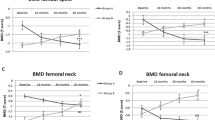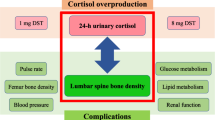Abstract
Summary
Analyses using the largest Korean cohort of adrenal incidentaloma (AI) revealed that subtle cortisol excess in premenopausal women and reduced dehydroepiandrosterone-sulfate (DHEA-S) in postmenopausal women and men are associated with bone mineral density (BMD) reduction in Asian patients with subclinical hypercortisolism (SH).
Introduction
Few studies evaluated bone metabolism in Asians with SH. We investigated associations of cortisol and DHEA-S, an adrenal androgen, with BMD in Asians with AI, with or without SH.
Methods
We used cross-sectional data of a prospective multicenter study from Korea. We measured BMD, bone turnover markers, cortisol levels after 1-mg dexamethasone suppression test (1-mg DST), DHEA-S, and baseline cortisol to DHEA-S ratio (cort/DHEA-S) in 109 AI patients with SH (18 premenopausal, 38 postmenopausal women, and 53 men) and 686 with non-functional AI (NFAI; 59 premenopausal, 199 postmenopausal women, and 428 men).
Results
Pre- and postmenopausal women, but not men, with SH had lower BMDs at lumbar spine (LS) than those with NFAI (P = 0.008~0.016). Premenopausal women with SH also had lower BMDs at the hip than those with NFAI (P = 0.009~0.012). After adjusting for confounders, cortisol levels after 1-mg DST demonstrated inverse associations with BMDs at all skeletal sites only in premenopausal women (β = − 0.042~− 0.033, P = 0.019~0.040). DHEA-S had positive associations with LS BMD in postmenopausal women (β = 0.096, P = 0.001) and men (β = 0.029, P = 0.038). The cort/DHEA-S had inverse associations with LS BMD in postmenopausal women (β = − 0.081, P = 0.004) and men (β = − 0.029, P = 0.011). These inverse associations of cort/DHEA-S remained significant after adjusting for cortisol levels after 1-mg DST (β = − 0.079~− 0.026, P = 0.006~0.029). In postmenopausal women, the odds ratios of lower BMD by DHEA-S and cort/DHEA-S was 0.26 (95% CI, 0.08–0.82) and 3.40 (95% CI, 1.12–10.33), respectively.
Conclusion
Subtle cortisol excess in premenopausal women and reduced DHEA-S in postmenopausal women and men may contribute to BMD reduction in Asians with SH.

Similar content being viewed by others
References
Fassnacht M, Arlt W, Bancos I, Dralle H, Newell-Price J, Sahdev A, Tabarin A, Terzolo M, Tsagarakis S, Dekkers OM (2016) Management of adrenal incidentalomas: European society of endocrinology clinical practice guideline in collaboration with the European network for the study of adrenal tumors. Eur J Endocrinol 175:G1–g34. https://doi.org/10.1530/eje-16-0467
Di Dalmazi G, Pasquali R, Beuschlein F, Reincke M (2015) Subclinical hypercortisolism: a state, a syndrome, or a disease? Eur J Endocrinol 173:M61–M71. https://doi.org/10.1530/eje-15-0272
Chiodini I (2011) Clinical review: diagnosis and treatment of subclinical hypercortisolism. J Clin Endocrinol Metab 96:1223–1236. https://doi.org/10.1210/jc.2010-2722
Chiodini I, Vainicher CE, Morelli V, Palmieri S, Cairoli E, Salcuni AS, Copetti M, Scillitani A (2016) Mechanisms in endocrinology: endogenous subclinical hypercortisolism and bone: a clinical review. Eur J Endocrinol 175:R265–r282. https://doi.org/10.1530/eje-16-0289
Fu J, Festen EA, Wijmenga C (2011) Multi-ethnic studies in complex traits. Hum Mol Genet 20:R206–R213. https://doi.org/10.1093/hmg/ddr386
Morelli V, Donadio F, Eller-Vainicher C, Cirello V, Olgiati L, Savoca C, Cairoli E, Salcuni AS, Beck-Peccoz P, Chiodini I (2010) Role of glucocorticoid receptor polymorphism in adrenal incidentalomas. Eur J Clin Investig 40:803–811. https://doi.org/10.1111/j.1365-2362.2010.02330.x
Siggelkow H, Etmanski M, Bozkurt S, Grobeta P, Koepp R, Brockmoller J, Tzvetkov MV (2014) Genetic polymorphisms in 11beta-hydroxysteroid dehydrogenase type 1 correlate with the postdexamethasone cortisol levels and bone mineral density in patients evaluated for osteoporosis. J Clin Endocrinol Metab 99:E293–E302. https://doi.org/10.1210/jc.2013-1418
Szappanos A, Patocs A, Gergics P, Bertalan R, Kerti A, Acs B, Feldmann K, Racz K, Toth M (2011) The 83,557insA variant of the gene coding 11beta-hydroxysteroid dehydrogenase type 1 enzyme associates with serum osteocalcin in patients with endogenous Cushing’s syndrome. J Steroid Biochem Mol Biol 123:79–84. https://doi.org/10.1016/j.jsbmb.2010.11.009
Tauchmanova L, Pivonello R, De Martino MC, Rusciano A, De Leo M, Ruosi C, Mainolfi C, Lombardi G, Salvatore M, Colao A (2007) Effects of sex steroids on bone in women with subclinical or overt endogenous hypercortisolism. Eur J Endocrinol 157:359–366. https://doi.org/10.1530/eje-07-0137
Lee SH, Song KH, Kim J, Park S, Ahn SH, Kim H, Cho YY, Suh S, Kim BJ, Kim JH, Koh JM (2017) New diagnostic criteria for subclinical hypercortisolism using postsurgical hypocortisolism: the co-work of adrenal research study. Clin Endocrinol 86:10–18. https://doi.org/10.1111/cen.13145
Kiel D (1995) Assessing vertebral fractures. National Osteoporosis Foundation Working Group on Vertebral Fractures. J Bone Miner Res 10:518–523. https://doi.org/10.1002/jbmr.5650100403
Genant HK, Wu CY, van Kuijk C, Nevitt MC (1993) Vertebral fracture assessment using a semiquantitative technique. J Bone Miner Res 8:1137–1148. https://doi.org/10.1002/jbmr.5650080915
Weaver B, Wuensch KL (2013) SPSS and SAS programs for comparing Pearson correlations and OLS regression coefficients. Behav Res Methods 45:880–895. https://doi.org/10.3758/s13428-012-0289-7
NIH Consensus Development Panel on Osteoporosis prevention, diagnosis, and therapy (2001) Osteoporosis prevention, diagnosis, and therapy JAMA 285:785–795
Chiodini I, Morelli V, Masserini B, Salcuni AS, Eller-Vainicher C, Viti R, Coletti F, Guglielmi G, Battista C, Carnevale V, Iorio L, Beck-Peccoz P, Arosio M, Ambrosi B, Scillitani A (2009) Bone mineral density, prevalence of vertebral fractures, and bone quality in patients with adrenal incidentalomas with and without subclinical hypercortisolism: an Italian multicenter study. J Clin Endocrinol Metab 94:3207–3214. https://doi.org/10.1210/jc.2009-0468
Canalis E, Mazziotti G, Giustina A, Bilezikian JP (2007) Glucocorticoid-induced osteoporosis: pathophysiology and therapy. Osteoporos Int 18:1319–1328. https://doi.org/10.1007/s00198-007-0394-0
Chiodini I, Torlontano M, Carnevale V, Guglielmi G, Cammisa M, Trischitta V, Scillitani A (2001) Bone loss rate in adrenal incidentalomas: a longitudinal study. J Clin Endocrinol Metab 86:5337–5341. https://doi.org/10.1210/jcem.86.11.8022
Hadjidakis D, Tsagarakis S, Roboti C (2003) Does subclinical hypercortisolism adversely affect the bone mineral density of patients with adrenal incidentalomas? Clin Endocrinol 58:72–77
Bardet S, Rohmer V, Boux de Casson F, Coffin C, Ronci N, Sabatier JP, Lecomte P, Audran M, Henry-Amar M, Tabarin A (2002) Bone density and biochemical bone markers in patients with adrenal incidentalomas: effect of subclinical hypercortisolism. Rev Med Interne 23:508–517
Dennedy MC, Annamalai AK, Prankerd-Smith O, Freeman N, Vengopal K, Graggaber J, Koulouri O, Powlson AS, Shaw A, Halsall DJ, Gurnell M (2017) Low DHEAS: a sensitive and specific test for the detection of subclinical hypercortisolism in adrenal incidentalomas. J Clin Endocrinol Metab 102:786–792. https://doi.org/10.1210/jc.2016-2718
Lee D, Kim H, Ahn SH, Lee SH, Bae SJ, Kim EH, Kim HK, Choe JW, Kim BJ, Koh JM (2015) The association between serum dehydroepiandrosterone sulphate (DHEA-S) level and bone mineral density in Korean men. Clin Endocrinol 83:173–179. https://doi.org/10.1111/cen.12755
Park SG, Hwang S, Kim JS, Park KC, Kwon Y, Kim KC (2017) The association between dehydroepiandrosterone sulfate (DHEA-S) and bone mineral density in Korean men and women. J Bone Metab 24:31–36. https://doi.org/10.11005/jbm.2017.24.1.31
Minetto M, Reimondo G, Osella G, Ventura M, Angeli A, Terzolo M (2004) Bone loss is more severe in primary adrenal than in pituitary-dependent Cushing’s syndrome. Osteoporos Int 15:855–861. https://doi.org/10.1007/s00198-004-1616-3
Ohmori N, Nomura K, Ohmori K, Kato Y, Itoh T, Takano K (2003) Osteoporosis is more prevalent in adrenal than in pituitary Cushing’s syndrome. Endocr J 50:1–7
Manolagas SC, Jilka RL (1995) Bone marrow, cytokines, and bone remodeling. Emerging insights into the pathophysiology of osteoporosis. N Engl J Med 332:305–311. https://doi.org/10.1056/NEJM199502023320506
Tauchmanova L, Rossi R, Nuzzo V, del Puente A, Esposito-del Puente A, Pizzi C, Fonderico F, Lupoli G, Lombardi G (2001) Bone loss determined by quantitative ultrasonometry correlates inversely with disease activity in patients with endogenous glucocorticoid excess due to adrenal mass. Eur J Endocrinol 145:241–247
Morelli V, Eller-Vainicher C, Salcuni AS, Coletti F, Iorio L, Muscogiuri G, Della Casa S, Arosio M, Ambrosi B, Beck-Peccoz P, Chiodini I (2011) Risk of new vertebral fractures in patients with adrenal incidentaloma with and without subclinical hypercortisolism: a multicenter longitudinal study. J Bone Miner Res 26:1816–1821. https://doi.org/10.1002/jbmr.398
Eller-Vainicher C, Morelli V, Ulivieri FM, Palmieri S, Zhukouskaya VV, Cairoli E, Pino R, Naccarato A, Scillitani A, Beck-Peccoz P, Chiodini I (2012) Bone quality, as measured by trabecular bone score in patients with adrenal incidentalomas with and without subclinical hypercortisolism. J Bone Miner Res 27:2223–2230. https://doi.org/10.1002/jbmr.1648
Kim BJ, Kwak MK, Ahn SH, Kim JS, Lee SH, Koh JM (2018) The association of cortisol and adrenal androgen with trabecular bone score in patients with adrenal incidentaloma with and without autonomous cortisol secretion. Osteoporos Int 29:2299–2307. https://doi.org/10.1007/s00198-018-4608-4
Funding
This study was supported by grants from the National Research Foundation funded by the Korea government (Project No. NRF-2017R1C1B2009158), the Korea Health Technology R&D Project, Ministry of Health and Welfare, Republic of Korea (Project No. HI15C0377), the Asan Institute for Life Sciences, Seoul, Republic of Korea (Project no. 2016-347), and Dong-A ST (Seoul, Korea).
Author information
Authors and Affiliations
Corresponding authors
Ethics declarations
Ethical approval
All procedures performed in studies involving human participants were in accordance with the ethical standards of the institutional and/or national research committee and with the 1964 Helsinki declaration and its later amendments or comparable ethical standards.
Informed consent
Informed consent was obtained from all individual participants included in the study.
Conflicts of interest
None.
Additional information
Publisher’s note
Springer Nature remains neutral with regard to jurisdictional claims in published maps and institutional affiliations.
Seong Hee Ahn and Jae Hyeon Kim are the joint first authors
Electronic supplementary material
ESM 1
(PDF 119 kb)
Rights and permissions
About this article
Cite this article
Ahn, S., Kim, J.H., Cho, Y.Y. et al. The effects of cortisol and adrenal androgen on bone mass in Asians with and without subclinical hypercortisolism. Osteoporos Int 30, 1059–1069 (2019). https://doi.org/10.1007/s00198-019-04871-5
Received:
Accepted:
Published:
Issue Date:
DOI: https://doi.org/10.1007/s00198-019-04871-5




